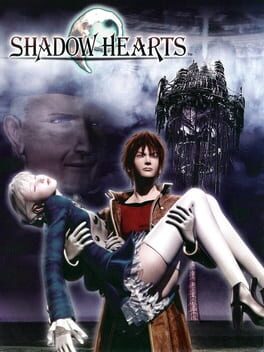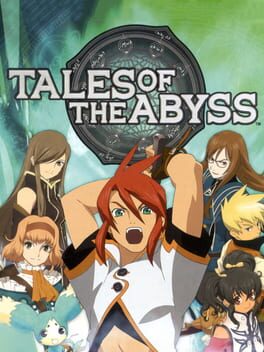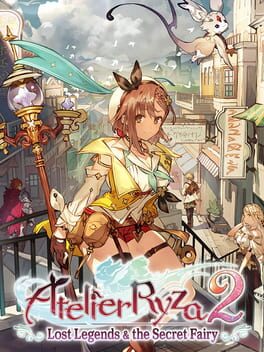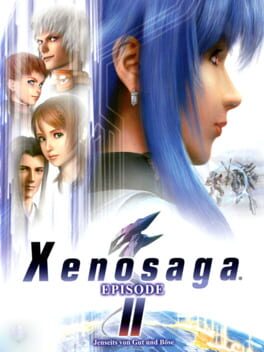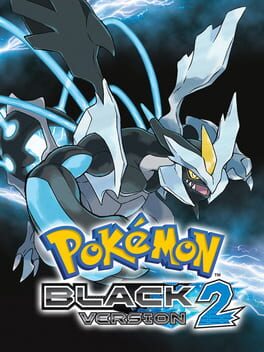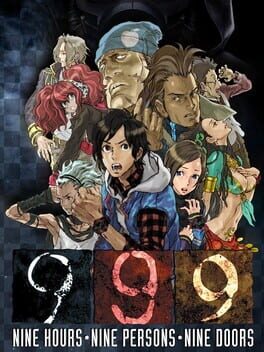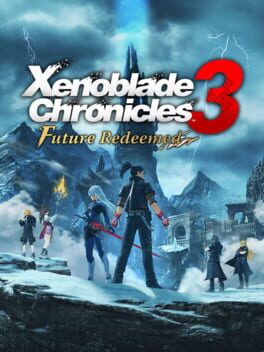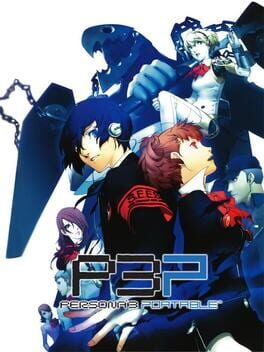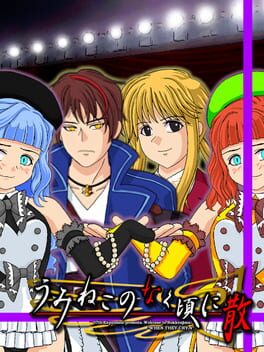Kawotari
55 reviews liked by Kawotari
Shadow Hearts
2001
This is a game and a series that a close friend of mine has been telling me is great for years. I’ve actually even owned the first two Shadow Hearts games for years as well, but I’ve always been a little too intimidated by the mechanics to properly give them a try. But over this summer break, I resolved to finally play through the Shadow Hearts series, and that’s just what I did~. It took me about 38 hours to play through enough to get the good ending on the Japanese version of the game on real hardware.
Shadow Hearts follows the story of Yuri, a young, foul-mouthed young man with the power to fuse with the souls of monsters he destroys. The year is 1913. At the directions of a mysterious voice in his head, he saves a young woman named Alice on a trian in Japanese occupied Manchuria. The powerful and dark sorcerer that he saves her from seems to let them get away purely out of whimsy, and so begins our tale. A tale that is often as dark as it is camp, and it really begins as it means to carry on in that regard x3
Coming out barely a month before Final Fantasy X, Shadow Hearts was then and is now very much a game living in the shadow (excuse the pun) of other great games on the system, but that isn’t to say that it doesn’t have excellent writing itself as well. It has an approach to myth, legend, and history that blends the three together in such a way that gives its places a delightfully uncanny presentation, and the game is delightfully creepy as often as it is just silly with how oddball its, at times incredibly joyfully anachronistic, characters can be. Given the time and location of the setting, there is a LOT that could’ve gone wrong in this game’s depictions of the places and people that appear in it, but by and large it very deftly handles its respective subject matters. The main writer of Shadow Hearts has said that a major inspiration was the original Devil Man manga, and it really shows with how painstakingly he goes out of his ways to paint villains and heroes alike in shades of grey, never settling comfortably into flatly evil archetypes. The major theme of depression and overcoming it with the help of those around you (or not doing that) is handled really well, and this is easily one of my new favorite written games on the console as a result.
The only real negative I can give about the writing is a really awful homophobic stereotype found in one of the merchant NPCs. Given the skill that the rest of the game’s subject matters are handled, it was a really uncomfortable and unfortunate pitfall of the game’s writing, and while it is just a minor character, it’s hard to overlook it when the stereotype is quite as bad as it is. It wasn’t a deal-breaker for me (and I tend to be pretty strict about that kind of stuff), but I absolutely understand it being too uncomfortable a depiction for others, as it’s really no better in the English version, by all accounts.
The mechanics of Shadow Hearts really show the nature of a company composed largely of ex-SquareSoft developers. It’s a pretty standard turn-based game RPG with two rows for your party of 3 to occupy, but with a few important and ever present gimmicks here and there. First and foremost among these is the Judgment Ring system, which is something all of the Shadow Hearts games have but none more than this. Upon selecting an attack, a quick time event of a spinning ring pops up, and you need to press the command button when the spinning dial is over the colored sections. For normal attacks, each successive press gets you another hit in your little combo, and for spells, you need to hit more and more successes for successively more powerful spells (meaning the QTE’s get tougher as the game goes on). Later Shadow Hearts games have the ability to turn off the Judgment Ring system, but that is not the case in the first game . It’s not super difficult to get a hold of (and the whole reason I thought it was so hard at first was because I’d been doing it wrong ^^; ), but it’s something that’s ever present enough for both combat and out of combat mini-games that, if you don’t like it, it’ll likely drive you crazy.
The other major mechanical gimmick is the sanity point (SP) system, which other Shadow Hearts games would also continue to use. For every turn you take, your sanity ticks down by one until it hits zero. Once it hits zero, you go berserk and you can’t control that character anymore. This means you need to keep on top of keeping people’s sanity up with healing items (whose use also requires use of the Judgement Ring), especially during longer fights and boss battles. This is especially true for Yuri, who takes far more sanity points per turn when he’s fused into a more powerful demon form. While a lot of Yuri’s fusion forms really don’t matter much (the balancing of the game means that more often than not, less than half of them end up being really necessary or useful), you basically always want him in his fusion form if you can help it because it makes him just SO much more powerful, and he also doesn’t get spells to use outside of fusion forms. This ultimately just adds more balls into the air to juggle in boss fights, and it’s one more thing to keep track of in addition to health and mana and such. It’s not a great mechanic, but it’s not an outright bad one either.
All in all, the difficulty balancing is done really well, and it keeps a very persistent air of being just hard enough to be challenging while very infrequently being something you’d feel you’d need to grind to get past. The only real “well that sucks” aspect of boss fight design is usually getting to one and realizing that it has some status effect that it’ll inflict that will make your life miserable, so you’ll need to load your save and go grab some status immunity accessories at a vendor to take care of that. Thankfully, HP, MP, and even SP replenishing items are at shops as well as these immunity items, meaning you’re only ever a little bit of money away from making a fight or particular bit of grinding eminently survivable. It’s another aspect where I certainly wish the game were balanced in such a way that you didn’t need to rely on having stuff like a bunch of SP healing items or status effect immunity accessories to progress, but the game being that way isn’t inherently a bad thing. It’s just a little annoying.
The presentation of Shadow Hearts is absolutely excellent in a way you’d really expect from a dev team made of ex-SquareSoft developers. From the way the 3D models look to the pre-rendered environments they move around on, this almost has the vibe of a super PS1 game in certain respects. The music is also excellent, and the creature and character design is awesome too. The game has a lot of really gross and creepy monster and boss design, and I don’t blame them for apparently implementing Yuri’s fusion system entirely to use more of the sick-ass monster designs they’d made. They’re great! X3
Verdict: Highly Recommended. From the writing to the presentation to the fun & engaging gameplay, Shadow Hearts is an incredibly strong RPG on a system with no shortage of them. The fact that it’s such an early RPG on the console makes that fact all the more impressive. If you’re a fan of creepy, myth-filled (think SMT-vibes) settings and turn-based RPG gameplay, Shadow Hearts is absolutely not a game to miss out on.
Shadow Hearts follows the story of Yuri, a young, foul-mouthed young man with the power to fuse with the souls of monsters he destroys. The year is 1913. At the directions of a mysterious voice in his head, he saves a young woman named Alice on a trian in Japanese occupied Manchuria. The powerful and dark sorcerer that he saves her from seems to let them get away purely out of whimsy, and so begins our tale. A tale that is often as dark as it is camp, and it really begins as it means to carry on in that regard x3
Coming out barely a month before Final Fantasy X, Shadow Hearts was then and is now very much a game living in the shadow (excuse the pun) of other great games on the system, but that isn’t to say that it doesn’t have excellent writing itself as well. It has an approach to myth, legend, and history that blends the three together in such a way that gives its places a delightfully uncanny presentation, and the game is delightfully creepy as often as it is just silly with how oddball its, at times incredibly joyfully anachronistic, characters can be. Given the time and location of the setting, there is a LOT that could’ve gone wrong in this game’s depictions of the places and people that appear in it, but by and large it very deftly handles its respective subject matters. The main writer of Shadow Hearts has said that a major inspiration was the original Devil Man manga, and it really shows with how painstakingly he goes out of his ways to paint villains and heroes alike in shades of grey, never settling comfortably into flatly evil archetypes. The major theme of depression and overcoming it with the help of those around you (or not doing that) is handled really well, and this is easily one of my new favorite written games on the console as a result.
The only real negative I can give about the writing is a really awful homophobic stereotype found in one of the merchant NPCs. Given the skill that the rest of the game’s subject matters are handled, it was a really uncomfortable and unfortunate pitfall of the game’s writing, and while it is just a minor character, it’s hard to overlook it when the stereotype is quite as bad as it is. It wasn’t a deal-breaker for me (and I tend to be pretty strict about that kind of stuff), but I absolutely understand it being too uncomfortable a depiction for others, as it’s really no better in the English version, by all accounts.
The mechanics of Shadow Hearts really show the nature of a company composed largely of ex-SquareSoft developers. It’s a pretty standard turn-based game RPG with two rows for your party of 3 to occupy, but with a few important and ever present gimmicks here and there. First and foremost among these is the Judgment Ring system, which is something all of the Shadow Hearts games have but none more than this. Upon selecting an attack, a quick time event of a spinning ring pops up, and you need to press the command button when the spinning dial is over the colored sections. For normal attacks, each successive press gets you another hit in your little combo, and for spells, you need to hit more and more successes for successively more powerful spells (meaning the QTE’s get tougher as the game goes on). Later Shadow Hearts games have the ability to turn off the Judgment Ring system, but that is not the case in the first game . It’s not super difficult to get a hold of (and the whole reason I thought it was so hard at first was because I’d been doing it wrong ^^; ), but it’s something that’s ever present enough for both combat and out of combat mini-games that, if you don’t like it, it’ll likely drive you crazy.
The other major mechanical gimmick is the sanity point (SP) system, which other Shadow Hearts games would also continue to use. For every turn you take, your sanity ticks down by one until it hits zero. Once it hits zero, you go berserk and you can’t control that character anymore. This means you need to keep on top of keeping people’s sanity up with healing items (whose use also requires use of the Judgement Ring), especially during longer fights and boss battles. This is especially true for Yuri, who takes far more sanity points per turn when he’s fused into a more powerful demon form. While a lot of Yuri’s fusion forms really don’t matter much (the balancing of the game means that more often than not, less than half of them end up being really necessary or useful), you basically always want him in his fusion form if you can help it because it makes him just SO much more powerful, and he also doesn’t get spells to use outside of fusion forms. This ultimately just adds more balls into the air to juggle in boss fights, and it’s one more thing to keep track of in addition to health and mana and such. It’s not a great mechanic, but it’s not an outright bad one either.
All in all, the difficulty balancing is done really well, and it keeps a very persistent air of being just hard enough to be challenging while very infrequently being something you’d feel you’d need to grind to get past. The only real “well that sucks” aspect of boss fight design is usually getting to one and realizing that it has some status effect that it’ll inflict that will make your life miserable, so you’ll need to load your save and go grab some status immunity accessories at a vendor to take care of that. Thankfully, HP, MP, and even SP replenishing items are at shops as well as these immunity items, meaning you’re only ever a little bit of money away from making a fight or particular bit of grinding eminently survivable. It’s another aspect where I certainly wish the game were balanced in such a way that you didn’t need to rely on having stuff like a bunch of SP healing items or status effect immunity accessories to progress, but the game being that way isn’t inherently a bad thing. It’s just a little annoying.
The presentation of Shadow Hearts is absolutely excellent in a way you’d really expect from a dev team made of ex-SquareSoft developers. From the way the 3D models look to the pre-rendered environments they move around on, this almost has the vibe of a super PS1 game in certain respects. The music is also excellent, and the creature and character design is awesome too. The game has a lot of really gross and creepy monster and boss design, and I don’t blame them for apparently implementing Yuri’s fusion system entirely to use more of the sick-ass monster designs they’d made. They’re great! X3
Verdict: Highly Recommended. From the writing to the presentation to the fun & engaging gameplay, Shadow Hearts is an incredibly strong RPG on a system with no shortage of them. The fact that it’s such an early RPG on the console makes that fact all the more impressive. If you’re a fan of creepy, myth-filled (think SMT-vibes) settings and turn-based RPG gameplay, Shadow Hearts is absolutely not a game to miss out on.
Tales of the Abyss
2005
This review contains spoilers
The most obvious change from previous game is the stylistic shift in character designs, more realism and less weird doll anime look. Realism with ps2 hardware was no easy feat and this is not a Capcom game so unfortunately these models do not end up looking great. For some reason the characters look like they have a lower overall polycount than they did in the first game (hands with fingers are replaced by these ps1 era blocks, no teeth in mouth etc) which results in the ingame cutscenes really not being a pleasure to look at.
While the art style does hold up better in the pre-rendered cutscenes, those are few and far between and despite me not liking 1's look either, I'd say this is kind of a downgrade.
Maybe to go along with the new aesthetic, half the game's Voice Actors were recast and its also just a complete downgrade across the board, went from honestly great all around voice acting to the classic robotic English JRPG voice acting with chaos' nasal voice being probably worst offender.
The combat changes essentially boil down to 1's combat being boring and 2's being tedious, pick your poison.
The combat simply lasts too long during random encounters due to you dealing 0 damage if the enemy is an neutral state and combos requiring you to first charge for multiple turns.
It does have its moments during more drawn out boss fights but the game will still find ways to piss you off. The returning roulette wheel ends up feeling completely out of place in this game, trying to sync your multi turn combo so you land on the bonus points when you finish the enemy while also playing around the newly added random slot which can roll into reverse boost!!! giving boost to the enemy instead ends up being really annoying.
Enemies naturally have a boost gauge of their own which they seemingly use randomly so even if you get the perfect set up the boss can just boost before you knock him up (this also overrides whatever boost was already used by the player) and ruin your plan.
On the plus side, Xenosaga 2 has by far the most robust side content out of the 3, it offers an actual quest log (crazy!!) with 36 quests some of which are really fleshed out and some that are complete dogshit (4 and 32 especially) alongside 3 pretty lengthy post game dungeons.
The narrative puts a lot of focus on Jr and Albedo's relationship (to a point where Shion and KOS-MOS become background characters) but it doesn't really end up adding much to what I would consider the least interesting part of episode 1.
The pacing also feels really weird with the events of the story unfolding in this somewhat abrupt fashion. You're jumping from place to place and it all feels kind of disjointed and nothing really gets any room to breathe. This especially applies to the "main" antagonist who shows up -> speaks like 2 lines of dialogue -> fights -> dies.
Due to the focus shift, it isn't until the final cutscene where we get actual development on some of the things Episode 1 set up and this pretty much leaves Episode 3 to do all the heavy lifting.
While the art style does hold up better in the pre-rendered cutscenes, those are few and far between and despite me not liking 1's look either, I'd say this is kind of a downgrade.
Maybe to go along with the new aesthetic, half the game's Voice Actors were recast and its also just a complete downgrade across the board, went from honestly great all around voice acting to the classic robotic English JRPG voice acting with chaos' nasal voice being probably worst offender.
The combat changes essentially boil down to 1's combat being boring and 2's being tedious, pick your poison.
The combat simply lasts too long during random encounters due to you dealing 0 damage if the enemy is an neutral state and combos requiring you to first charge for multiple turns.
It does have its moments during more drawn out boss fights but the game will still find ways to piss you off. The returning roulette wheel ends up feeling completely out of place in this game, trying to sync your multi turn combo so you land on the bonus points when you finish the enemy while also playing around the newly added random slot which can roll into reverse boost!!! giving boost to the enemy instead ends up being really annoying.
Enemies naturally have a boost gauge of their own which they seemingly use randomly so even if you get the perfect set up the boss can just boost before you knock him up (this also overrides whatever boost was already used by the player) and ruin your plan.
On the plus side, Xenosaga 2 has by far the most robust side content out of the 3, it offers an actual quest log (crazy!!) with 36 quests some of which are really fleshed out and some that are complete dogshit (4 and 32 especially) alongside 3 pretty lengthy post game dungeons.
The narrative puts a lot of focus on Jr and Albedo's relationship (to a point where Shion and KOS-MOS become background characters) but it doesn't really end up adding much to what I would consider the least interesting part of episode 1.
The pacing also feels really weird with the events of the story unfolding in this somewhat abrupt fashion. You're jumping from place to place and it all feels kind of disjointed and nothing really gets any room to breathe. This especially applies to the "main" antagonist who shows up -> speaks like 2 lines of dialogue -> fights -> dies.
Due to the focus shift, it isn't until the final cutscene where we get actual development on some of the things Episode 1 set up and this pretty much leaves Episode 3 to do all the heavy lifting.
Pokémon Shield
2019
This is potentially my favourite game of all time, with some bias due to sentiment. I have clocked at least 1000 hours on this 30hr RPG across 6 playthroughs, without ever accessing the online features. At one point I'd replayed this game once per year, which makes me want to do it again now. The Unova pokedex contains some of the most creative designs to date (my favourites being zoroark, chandelure, hydreigon) but unlike its predecessor, mixes in the older pokemon in a way that feels natural. It's so cool that I can catch riolu in like the 3rd route of the game! The music is the best this game. It's the graphical peak of the series, with incredibly lively animations and gorgeous spritework. The pacing of the story is strong, the game is a great difficulty for nuzlockes and the postgame is only rivaled by ORAS which came years later. This game squeezed every bit of value out of the DS and is simply perfect for this era of the series. Literally PEAK.
Persona 3 Portable
2009
this is the best version of persona 3 - you don't lose much without the FES cutscenes, and the answer is a huge slog to play. the visual novel / point and click format really helps the pacing of the mundane segments, and the PS2 versions just don't offer enough in the way of interesting direction or animation for me to feel much loss. very easy game with party control, but you won't have to suffer from suicidal AI ruining your run, and there's difficulty options to keep you engaged enough. disclaimer: do not try and 100% this game. it will make your experience worse.
incredibly interesting game with a real narrative and thematic vision and mechanics built to match it. points off for the poor social links on both sides and abysmal main story pacing. i like this cast the most of every modern persona, and they're all given sufficient material to work with in the narrative throughout - benefits of minimal party social links! that said, it can be a slog: tartarus isn't too interesting, but the floors are at least shorter, and a lot of the mechanics will work against you wanting to play with it the best. very neat game that could've done with refinement in sequels. unfortunately, that never happened.
incredibly interesting game with a real narrative and thematic vision and mechanics built to match it. points off for the poor social links on both sides and abysmal main story pacing. i like this cast the most of every modern persona, and they're all given sufficient material to work with in the narrative throughout - benefits of minimal party social links! that said, it can be a slog: tartarus isn't too interesting, but the floors are at least shorter, and a lot of the mechanics will work against you wanting to play with it the best. very neat game that could've done with refinement in sequels. unfortunately, that never happened.
